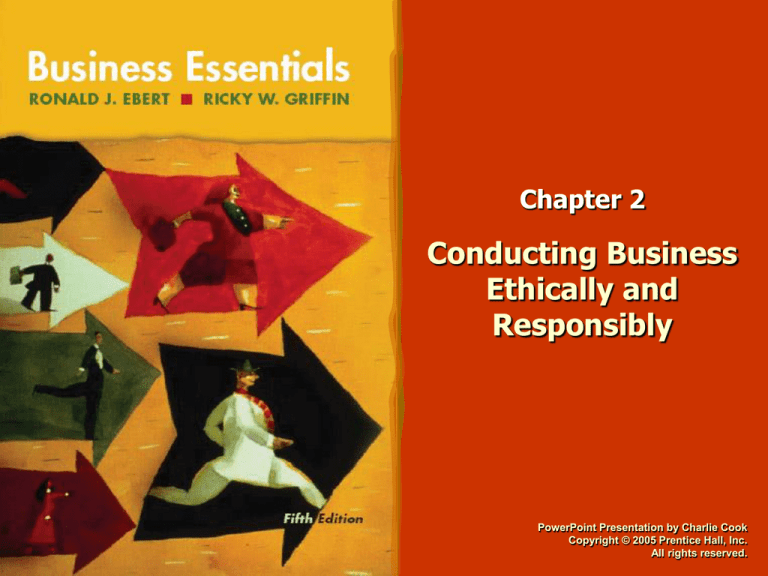
Chapter 2
Conducting Business
Ethically and
Responsibly
PowerPoint Presentation by Charlie Cook
Copyright © 2005 Prentice Hall, Inc.
All rights reserved.
“The more I help others to
succeed, the more I succeed.”
— Ray Kroc, Founder, McDonald’s
Copyright © 2005 Prentice Hall, Inc. All rights reserved.
2–2
Key Topics
• Individual codes of ethics and the
importance of ethics in the workplace
• Key terms
Social responsibility in U.S. business
Environmental issues and stakeholder
relationships
Approaches and implementation
Implications for small business
Copyright © 2005 Prentice Hall, Inc. All rights reserved.
2–3
What Is Ethical Behavior?
• Ethics
Right and wrong, good
and bad, in actions that
affect others
• Ethical Behavior
Conforming to
generally accepted
ethical norms
Copyright © 2005 Prentice Hall, Inc. All rights reserved.
2–4
Ethical Considerations
• Regarding a particular act…
Utility: Does it optimize what is best for those who
are affected by it?
Rights: Does it respect the rights of the individuals
involved?
Justice: Is it consistent with what we regard as fair?
Caring: Is it consistent with people’s responsibilities
to each other?
Copyright © 2005 Prentice Hall, Inc. All rights reserved.
2–5
Expanded Model of Ethical Judgment Making
Gather the facts concerning the act or policy
Data
Gathering
Is the act or policy acceptable according to the four ethical norms?
• Utility: Does it optimize the satisfaction of all constituencies?
• Rights: Does it respect the rights and duties of the individuals involved?
• Justice: Is it consistent with the canons of justice?
• Caring: Is it consistent with the responsibility to care?
Analysis
No on all
No on one or
Yes on all
criteria
two criteria
criteria
Is there any reason for overriding one or two of the ethical norms?
Is one ethical norm more important than the others?
Is there any reason why a person may have been forced into
committing an act or following a policy?
No
Judgment
The act or policy is not ethical.
Copyright © 2005 Prentice Hall, Inc. All rights reserved.
Yes
The act or policy is ethical.
Figure 2–2
2–6
Company Practices and Business Ethics
Best Approach: Open, Honest, Responsive!
The Coca Cola Scare Case
The Tylenol Scare Case
Copyright © 2005 Prentice Hall, Inc. All rights reserved.
2–7
How Much Privacy Does Your Employer
Owe You?
• Email
• Internet
• Cellular Phones
Copyright © 2005 Prentice Hall, Inc. All rights reserved.
2–8
Formalizing the Commitment to Ethics
Adopting Written Codes
Instituting Ethics Programs
Copyright © 2005 Prentice Hall, Inc. All rights reserved.
2–9
Social Responsibility: Balancing
Commitments to Stakeholders
• Stakeholders
Groups, individuals, and organizations that are
directly affected by the practices of an organization
Employees
Customers
Investors
CORPORATION
Suppliers
Local Communities
Copyright © 2005 Prentice Hall, Inc. All rights reserved.
2–10
Responsibility Toward the Environment
• Air pollution
• Water pollution
• Land pollution
Toxic waste
Recycling
Copyright © 2005 Prentice Hall, Inc. All rights reserved.
2–11
Responsibility Toward Customers
Consumer Rights
Unfair Pricing
Ethics in Advertising
Copyright © 2005 Prentice Hall, Inc. All rights reserved.
2–12
Responsibility Toward Employees
Legal and Social
Commitments
Copyright © 2005 Prentice Hall, Inc. All rights reserved.
Whistle-blowers
2–13
Responsibility Toward Investors
• Improper financial
management
• Check kiting
• Insider trading
• Misrepresentation of
finances
Copyright © 2005 Prentice Hall, Inc. All rights reserved.
2–14
Approaches to Social Responsibility
Level of Social Responsibility
Highest
Lowest
Obstructionist
Stance
Actively
Avoids
Responsibility
Defensive
Stance
Does Legal
Minimum
Copyright © 2005 Prentice Hall, Inc. All rights reserved.
Accommodative
Stance
Responds to
Requests
Proactive
Stance
Actively Seeks
Opportunities
to Contribute
2–15
Ethics, Social Responsibility, and the
Small Business
Do small businesses face
different issues with regard
to ethics and social
responsibility?
Copyright © 2005 Prentice Hall, Inc. All rights reserved.
2–16
Chapter Review
• Discuss how individuals develop their personal codes of
ethics.
• Explain why ethics matter in the workplace.
• Distinguish social responsibility from ethics.
• Show how social responsibility applies to environmental issues
and to relationships with customers, employees, and investors.
• Identify four approaches to social responsibility.
• Describe the four steps a firm must take to implement a social
responsibility program.
• Explain how social responsibly and ethics affect small
business.
Copyright © 2005 Prentice Hall, Inc. All rights reserved.
2–17






